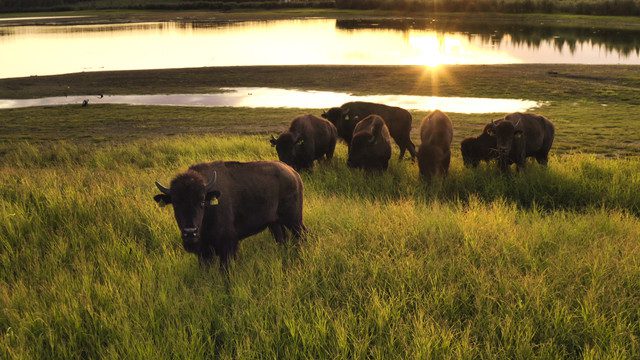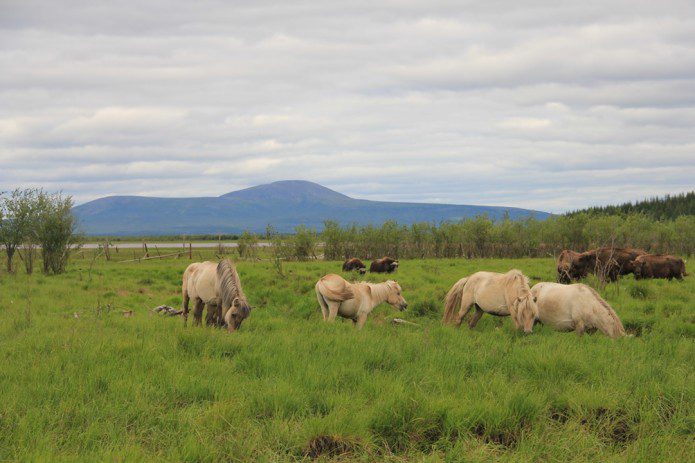
An artist’s renderings of the mammoth steppe. Courtesy Pleistocene Park Foundation.
Through the work spearheaded by one family, an ecosystem reengineering experiment is bringing new life to the Arctic. It’s an effort to stop the thaw of permafrost and the impending, enormous release of its greenhouse gasses.
Nearly 20,000 years ago, millions of woolly mammoths, bison, oxen, horse, and reindeer lived in the grassland steppe of northern Siberia. Today, the landscape is largely a barren tundra, a once-great grassland ecosystem ruined through hapless human activity. However, things are starting to change. In one corner of Siberia, Sergey Zimov and son Nikita are leading a charge to restore the lost mammoth steppe of the Pleistocene era.
The Zimov’s effort, called Pleistocene Park, is a 160-square-kilometer reserve—located 3,300 miles (5,400 km) from Moscow and half that from Anchorage, Alaska. The family is going to great lengths to create this transformation and has started a Patreon campaign to build support.
BECOME A PATRON OF PLEISTOCENE PARK AND SUPPORT THE WORK TO REWILD THE ARCTIC.
Their goal is to restore the variety and density of grazing animals that once roamed here. In June 2019 Nikita completed an expedition to deliver a group of 12 steppe bison from Denmark to Pleistocene Park—driving the entire width of Eurasia to do so. These bison joined reindeer, Yakutian horse, moose, musk ox, yak, Kalmykian cow, and sheep. Now there is a group of 100 different animals representing 8 major herbivore species. And, with help from the Church Lab at Harvard and Revive & Restore, advances are being made to de-extinct the Woolly Mammoth so that, it too, can join the enormous task of re-making grasslands.

The bison at Pleistocene Park were brought in from Denmark. Courtesy Pleistocene Park Foundation.
The reason for all this effort? To counter the effects of climate change. That’s because a real worry in the Arctic involves the permafrost that sits underground. If temperatures increase just slightly in the permafrost, its thaw will release an enormous amount of methane and carbon dioxide into the air, to an extent that no other ecosystem source can compare. But the presence of megaherbivores can actually lower ground temperatures and stop the thaw. By trampling across the ground in wintertime, the herbivores break up the snow and expose the ground directly to severe winter temperatures, thus re-chilling the permafrost below. By encouraging megafaunal activity upon the snowy grasslands, the Zimovs are enabling colder and deeper winter soil freezing.
A recent article in Philosophical Transactions of the Royal Society calls the experiment “one of the most audacious hypotheses proposed in this region.” The paper also concludes the Zimov’s plan could work.
ACCESS THE PHILOSOPHICAL TRANSACTIONS OF THE ROYAL SOCIETY PAPER, HERE.
Other than the snow effect, the publication outlines the many ways that Arctic megafaunal ecological engineering can be a climate solution. It turns out that the replacement of forests with grassland has multiple benefits. For one, grasses reflect more light than today’s dominant woody shrubs—all year round. This effect, called albedo, sends radiant energy back to space and lowers atmospheric temperatures. The grasses also work to transfer water out of the soil and into the atmosphere, further lowering ground temperatures and decreasing waterlogging. Plus, the deeper root structures of grasses do a better job of storing carbon in the soil than those of the shrubs and larch they replace.
Altogether, the effects of a restored grassland tended to by megaherbivores, “implies an enhanced protection of the carbon-rich permafrost,” says the paper, “with consequently reduced carbon emissions from permafrost thaw, increased carbon capture and an overall negative feedback to global warming.” The paper concluded that the benefits to the local area may be most felt by as an economic gain in carbon-offset markets. Institutional friction and the potential role of new technologies in the reintroductions are also discussed.

The animal species in Pleistocene Park have not grazed together in Siberia for 10,000 years. Courtesy Pleistocene Park Foundation.



